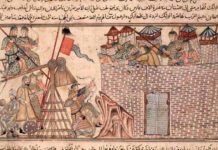Ilkhanate was part of the Mongol Empire which stretched west to what is now Georgia and Armenia, east to Pakistan, south to the southern coast of Iran and north to Turkey and Afghanistan. The region had been under rule of the Mongols since Genghis Khan’s invasions of the Khwarezmian Empire from 1219 through 1224. In 1251, when Mongke Khan (who was Genghis Khan’s grandson) became Great Khan, the empire set their sights on further expansion. Mongke chose his brother, Hulagu Khan, to put the plan into action.
The Mongols were a powerful force. Under his brother’s direction to spare those who surrendered peacefully but destroy those who didn’t, Hulagu carved a path which led the army into Iraq and Syria. Hulagu picked up forces on the way, choosing often from those whom he’d spared. Soon, he was leading a mixed military made up of Mongol and Frankish forces.
The sweeping crusade of the Mongols had been one based on their faith. The majority of Mongols were Bhuddist or Christian. Their ambition was to not only fulfill Genghis Khan’s quest to rule the world, but in the process wipe clean the countries where the Islamic faith was prominent. In a brazen act, Hulagu sent a group of envoys to Egypt, warning that his army was on the way and that they could not be stopped. The only options were to surrender or be destroyed.
Qutuz, the Sultan of Cairo defied the request and instead killed the envoys and hung their heads at the city’s gates. He then sent his forces through what is modern day Israel in route to meet the Mongols head-on.
Yet, just as the Mongols prepared for the confrontation, Great Khan, Mongke Khan, died in an expedition to China and Hulagu was recalled to determine a successor, taking a portion of the army in the region with him. This left a still formidable 10,000-20,000 troops to face the approaching Mamluk resistance.
The armies met north of Jerusalem in Ain Jalut on September 3, 1260.
Qutuz, hid most of his forces in the mountains and tried to conserve his men by launching short engagements and retreating. This slowly drew the Mongols up into the highlands. There, they were ambushed by the hidden Mamluks.
In no small part, the Mamluks’ victory can be accredited to the use of hand cannons. These weapons (early ancestors of the musket) had the ability to not only scare with the explosive sound they emitted, but possessed killing power like the world had never seen.
With the world’s first firearm, a brilliant plan and the ferocious fighting of his army, Qutuz was the first to ever defeat the Mongol heavy calvary in such close quarters. Contrary to arriving back in Cairo to great celebration however, Qutuz was murdered in his route home as part of a conspiracy designed and executed by a rival Mamluk, Baibars, and his followers.
By 1263, Hulagu had devised a plan to avenge his loss at Ain Jalut, but it was never put into motion. Berke Khan, his cousin, who ruled another Mongol territory, had converted to Islam and was soon waging war against the more traditional Khans. Before long the Mongol Empire had started to crumble.
Hulagu Khan died in 1265.








